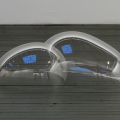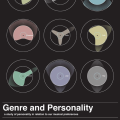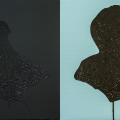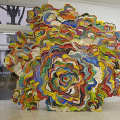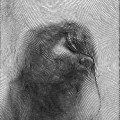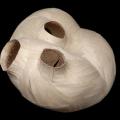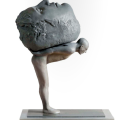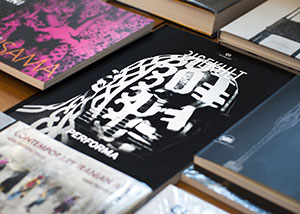This is touching. An exhausted phrase, perhaps, though to be touched is what we want, possibly more than ever. But what does it mean to be touched? At the very least, along the porous lines of the seen, felt, and heard, to be touched is to encounter the trace of an Other, either face-to-face or along the course of centuries. When registered, being touched can range from the merely amusing to the opening of worlds you didn’t know existed or were inhabitable. The body of this Other — hands, mind, eyes, and ears — converges with your own through their work (as it does now in reading me, however removed and mediated we are from each other).
Can we have or make sense without this touching, without our bodies? This is a central question in Jean-Luc Nancy’s prodigious writing on the body in Corpus (2006) — or more properly, not on the body, but to and from the body and the ex-scription that both body and writing imply: “Bodies, for good or ill, are touching each other upon this page, or more precisely, the page itself is a touching (of my hand while it writes, and your hands while they hold the book). This touch is infinitely indirect, deferred — machines, vehicles, photocopies, eyes, still other hands are all interposed — but it continues as a slight, resistant, fine texture, the infinitesimal dust of a contact, everywhere interrupted and pursued.”
Bodies of work touch each other endlessly. We would have no history or sharing of histories otherwise. Sometimes it’s nothing more than a brush or superficial affinity. Other times there’s a deep involvement, which may or may not have been there from the start, and moreover, may take years of work and the work of years to uncover (recalling Jacques Derrida, the “dissimulation of the woven texture can in any case take centuries to undo its web”[2]). All this to say, as Nancy does, that bodies and the proliferation of touching have generated the “whole corpus of a General Encyclopedia of Western Sciences, Arts, and Ideas.” [3] When laying a hand on this body, a corpus that surely extends beyond the West, it’s not the body of a specimen, a patient etherized upon a table, [4] but an inoperative one both living and dead, self and other, and above all, moving forward and backward, constantly coming together and pulling apart, and never seen or felt in totality. Within the finitude of our corpus, there are no out-of-body experiences. Once split, it is only through touching, with palms pressed and fingers interlaced, that the boy’s body gets a hold of itself. In sheer physicality, this self-touching is near impossible (and wholly impossible if stipulating the outstretched arms of M). In the process of casting the work, Krisár had to introduce a contamination, one that complicates a split identity ever further. This boy is not only both one and two, but also three (or two a second time), for to achieve this cast of self-touching another boy’s hand was needed (a friend of Johan’s). So some of these fingers are not Johan’s at all, and thus he only gets a hold of himself with the help of another (there is a complex set of traces and history of touches in this work, from artist to model, artist to sculpture, model to cast, and friend to model). This inability to cast a figure alone with itself performs the conceptual impossibility of being absolutely alone, an impossibility that has deep ethical and political import vis-à-vis community: “The absolute must be the absolute of its own absoluteness, or not be at all. In other words: to be absolutely alone, it is not enough that I be so; I must also be alone being alone — and this of course is contradictory.”[24] This figure that is split in at least more than one way — from himself and from the other who makes his self-relation possible in the first place — subtly critiques pure individuality at the broadest level: the self is forever indebted to the Other (be it via Emmanuel Levinas’s ethics of the face-to-face, Jean-Paul Sartre’s critique of solipsism through the shame-inducing gaze of the Other, Jacques Lacan’s mirror stage, Derrida’s deconstruction of pure presence in all its forms, or Nancy’s notion of community as founded on the realization of the Other’s death. French thought in the twentieth century is filled with this split between self and other).
Johan’s eyes are closed — but what would it mean for him to see himself? Or hear, smell, or speak to his other half? In all cases, the sense organs doing the sensing are split (one nostril, one eye, and one ear mirroring itself on either side, with only the mouth presumably torn apart from use, at least from speech). Nevertheless, they correlate to a consciousness that itself cannot be split to such an absolute degree. We know that generally the left side of the brain controls the right side of the body and vice versa. This means that were the brain to be split in two, none of these senses could function, or they would amount to nerve endings that fire without receivership or destination. Then would Johan even be there to call himself seeing, hearing, smelling, or touching? If the boy somehow opened his eyes to see his other half hanging on the wall, each eye would be seeing the side of the body that does that very seeing in question — an impossible thought. Presumably this would hold for smell and hearing, but what of the hands? If these hands could hold each other in such a way, without help from a friend, what would the touch feel like? Would one side feel itself being touched by the other without itself feeling itself touching back? It can happen that we wake in the middle of the night to a limb that remains asleep, which affords us some frighteningly uncanny moments of touching ourselves without that part feeling it, as if an arm or a leg is already cadaverous (though properly speaking, this reverses the roles of the toucher and touched, even though in both scenarios they are one and the same). No doubt these thoughts on touching are as impossible as those on sight, and the hypothetical sensory cut off that M poses is impossibly complete.
On the other hand, might it happen that Johan’s brain could remap itself unilaterally? Referring to Catherine Malabou’s work in philosophy and neuroscience,[25] would the brain’s plasticity allow it to adapt to a new form of functioning and sensory correlation with the body? Even so, would this not then result in two brains that control two disparate and halved bodies? Would we not then be dealing with two minds that betray the impossibility of a pure splitting of consciousness, which unlike M’s split body, we can’t even visualize hypothetically? This is not to say there are no maladies where minds are severely split or multiplied, on the contrary (and beyond the relational necessities of self and other, it is even difficult to think of a consciousness that is not split or multiple to some medico-socially acceptable degree). It is to say, however, that they are never split or multiplied in discrete purity, since it is the continued communication and contamination between voices, personalities, or moods, the passing over from one to the other, from one unpredictable moment to the next, in one person, in one body, which is so properly traumatic.
Anders Krisár: Visions Of A Missing Double
AUTHOR: Arnaud Gerspacher
LINK: www.anderskrisar.com
COMMENTSRELATED POST |
|
|
|
|


















